
Welche Opalfarbe ist am häufigsten? Finden Sie es in diesem Ratgeber heraus!
 Betrachtet man einen Opal, offenbart sich eine Welt voller Farben. Opale sind berühmt für ihr Farbenspiel, das die faszinierende Dynamik der Farben auf dem Stein beschreibt. Kein Opal zeigt nur eine Farbe. Doch welche Opalfarbe ist die häufigste? Um das zu beantworten, müssen wir die Grundfarbe (den Farbton) des Edelsteins betrachten. Weißer Opal ist die häufigste Farbe , gefolgt von grauem und grünem Opal.
Betrachtet man einen Opal, offenbart sich eine Welt voller Farben. Opale sind berühmt für ihr Farbenspiel, das die faszinierende Dynamik der Farben auf dem Stein beschreibt. Kein Opal zeigt nur eine Farbe. Doch welche Opalfarbe ist die häufigste? Um das zu beantworten, müssen wir die Grundfarbe (den Farbton) des Edelsteins betrachten. Weißer Opal ist die häufigste Farbe , gefolgt von grauem und grünem Opal.
Wer bei „gewöhnlich“ an „gewöhnlich“ denkt, sollte seine Meinung überdenken! Dieser Edelstein ist ein Meister der Tarnung, denn er schimmert in unzähligen Opalfarben. Doch Opal lässt sich nicht verbergen; sein Funkeln und sein bezauberndes Farbenspiel ziehen garantiert alle Blicke auf sich!
Apropos Augen: Eine Theorie zur Etymologie des Opals leitet sich vom griechischen Wort für Augen, ophthalmos, ab. Eine andere mögliche Quelle ist das Sanskritwort Uppal , was „kostbarer Milchstein“ bedeutet.
Oktobergeborene erkennen den wunderschönen Milchopal vielleicht als traditionellen Geburtsstein für Oktober. Wer im April geboren ist, kann die uralten, mystischen Geburtssteine mit wunderschönem Opalschmuck ehren.
Ganz gleich, wer ihn trägt, Opal ist ein bezaubernder Edelstein mit viel Charme. Um die häufigste Opalfarbe vollständig zu verstehen, müssen wir uns mit den verschiedenen Opalarten und ihrer Herkunft befassen.
Zunächst einmal zu den Grundlagen.

Was ist ein Opal?
Opal ist ein Mineraloid, das aus Siliziumdioxid und unterschiedlichen Mengen Wasser besteht. Im Gegensatz zu den meisten Edelsteinen besitzt Opal keine Kristallstruktur und keine einheitliche chemische Zusammensetzung, wodurch er amorph ist.
Opal gehört zu einer eigenen Edelsteinfamilie, der Opalfamilie. Opale erhalten ihren charakteristischen perlmuttartigen Glanz durch ihre innere Struktur, die aus dicht gepackten Kugeln besteht, welche das Licht in seine verschiedenen Farben aufspalten.
Welche Farbe hat Opal?
Man verbindet Opal vielleicht mit farbenfrohem Schimmern, das an die Regenbögen auf Seifenblasen erinnert. Schimmern ist jedoch ein spezifisches Merkmal des Edelopals .
Edelopal, auch bekannt als Edelsteinopal, ist eine Varietät, die ein faszinierendes Farbenspiel aufweist. Das heißt, wenn man den Stein im Licht dreht, leuchtet er in einer Vielzahl von Farben. Die Farben verändern sich je nach Betrachtungswinkel.
Die Farben von Edelsteinopalen variieren von Stein zu Stein. Manche Edelsteinopale haben eine dunkle Grundfarbe, beispielsweise Schwarz oder Königsblau. Andere weisen einen weißen Grundton auf. Bei manchen Edelsteinopalen ist die Grundfarbe so vielfältig, dass sie nicht mehr erkennbar ist.
Der Edelopal wird oft mit der Varietät „gewöhnlicher Opal“ verwechselt, die wir im Folgenden genauer betrachten werden.
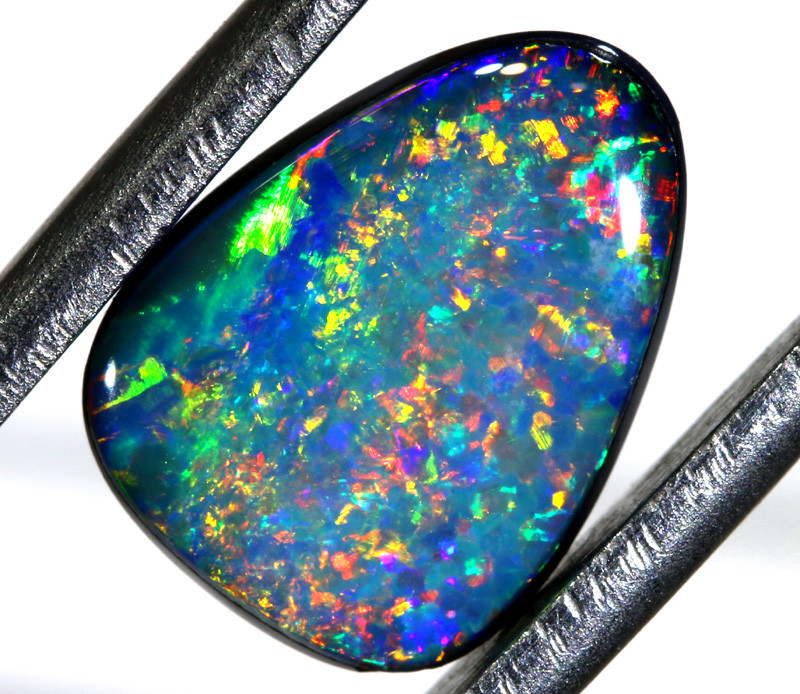
Was ist ein gewöhnlicher Opal?
Der gewöhnliche Opal, auch „Potch“ genannt, ist die weltweit am häufigsten vorkommende Opalart. Dieser Edelstein gibt es in einer breiten Farbpalette, und die meisten Opalarten fallen unter den Begriff „gewöhnlicher Opal“. Wie erkennt man einen gewöhnlichen Opal? Wenn der Stein kein Farbenspiel aufweist, handelt es sich um einen ganz normalen, gewöhnlichen Opal.
Ein weiteres charakteristisches Merkmal des gewöhnlichen Opals ist die Opaleszenz. Opaleszenz ist ein optischer Effekt, der das milchige, innere Leuchten des gewöhnlichen Opals beschreibt. Während beim Farbenspiel die Oberfläche eines Edelsteins Licht reflektiert, wirkt Opaleszenz wie ein diffuses Licht, das aus dem Inneren des Steins zu kommen scheint.
Gewöhnlicher Opal kann nahezu jede Farbe aufweisen, und seine Pastelltöne werden von vielen geschätzt. Am häufigsten hat gewöhnlicher Opal einen weißen oder blauen Grundton .
Welche ist die seltenste Opalfarbe? Die seltensten Opalexemplare haben einen roten oder schwarzen Körperton.
Ein schwarzer Körper eignet sich hervorragend, um eine weitere faszinierende Eigenschaft des Opals zur Geltung zu bringen: die Fluoreszenz.
Haben Sie schon einmal einen Leuchtstab zerbrochen? Das grüne Leuchten, das man danach sieht, entsteht durch Fluoreszenz. Opale können schwach oder stark fluoreszieren, sogar im gleichen Grünton wie Leuchtstäbe. Sie können aber auch gelblich-grün, hellblau, grünlich-braun oder weiß fluoreszieren.
Die Fluoreszenz von Opalen wird höchstwahrscheinlich durch Spuren von Uran im Inneren des Edelsteins verursacht. Ein höherer Urangehalt führt zu stärkerer Fluoreszenz. Einige fluoreszierende Opale aus Nevada enthalten sogar 0,12 Gewichtsprozent Uran !
Wir wissen, woher die Fluoreszenz des Opals kommt, aber woher kommt seine Farbe?

Was verursacht die Opalfarbe?
Gemeiner und kostbarer Opal entstehen größtenteils in denselben Umgebungen: tief im Gestein von Gebieten mit trockenem Klima. Bergleute müssen bis zu 18 Meter tief graben, um verkaufsfähigen Opal zu finden. Warum so tief? Nun, die Opalbildung dauert Millionen von Jahren.
Zuerst sickert heißes Wasser in den Boden. Während es in die Erde fließt, nimmt es Kieselsäurekügelchen auf. Schließlich sammelt sich das kieselsäurereiche Wasser in Hohlräumen des Gesteins. Beim Verdunsten des Wassers verdichten sich die Kieselsäurekügelchen und hinterlassen farbenprächtigen Opal.
Woher kommt die Opalfarbe? Sie lässt sich alles auf die Silicakugeln zurückführen.
Die Siliciumdioxid-Kügelchen im Opal sind technisch gesehen Siliziumdioxid-Kristalle. Wenn die Kügelchen annähernd gleich groß sind und dicht gestapelt angeordnet sind, entsteht ein faszinierendes Farbenspiel. Ist die Natur nicht erstaunlich? Die Größe jeder einzelnen Kugel bestimmt, welche Farbe des Lichts von diesem Bereich reflektiert wird.
Wenn Sie die Beiträge verfolgt haben, ist Ihnen vielleicht aufgefallen, dass nur Edelopale dicht gepackte Kugeln aufweisen. Falls ja, herzlichen Glückwunsch!
Die Siliziumdioxid-Kügelchen im gewöhnlichen Opal sind unregelmäßig angeordnet und weisen große Größenunterschiede auf. Daher kann gewöhnlicher Opal nicht das gesamte Lichtspektrum des Edelopals reflektieren. Stattdessen zeigt er nur ein begrenztes Farbspektrum, das durch die Größe und den Abstand seiner Kügelchen bestimmt wird.
Wie klingt die Suche nach Opalen, wenn man bedenkt, wie weit man reisen muss? Im Folgenden stellen wir Ihnen alle Opal-Hotspots weltweit vor, damit Sie Ihre nächste Opal-Reise planen können!
Opalfarben nach Fundort
Obwohl Opal in verschiedenen Gesteinen und an unterschiedlichen Orten vorkommt, entstehen in bestimmten Umgebungen unterschiedliche Opalfarben. Einige Fundorte sind für ihre Opalvarietäten bekannt.
Eine Stadt namens Coober Pedy in Südaustralien ist als „ Opalhauptstadt der Welt “ bekannt. Australien ist so berühmt für seine Opale, dass der Opal der nationale Edelstein des Landes ist!
Australien
Australien verfügt über einige der ergiebigsten Opalvorkommen der Welt. Tatsächlich stammen mindestens 90 % aller Opale weltweit aus Australien!
Jeder australische Bundesstaat, der Opale produziert, hat eine bestimmte Opal-Farbspezialität.
In den Abbaugebieten Westaustraliens ist rosa Opal weit verbreitet. „Rosa Opal“ ist eigentlich eine Handelsbezeichnung für Mookait mit Opalanteil. Opaliner Mookait kann jedoch Muster in Creme-, Gelb- und Rottönen aufweisen.
Ein weiterer Opalstein ist der Boulderopal .
Der in Queensland vorkommende Boulderopal ist eine Mischung aus Opal und Eisenstein. Jeder Boulderopal weist einzigartige Farben und Muster auf. Im Allgemeinen ist er braun mit vereinzelten leuchtenden violetten, blauen oder grünen Einschlüssen.
Die exklusive Farbe Schwarzopal ist eine Spezialität von New South Wales.
Schwarzer Opal ist unglaublich selten. Die wenigen Glücklichen, denen es gelingt, einen schwarzen Opal zu ergattern, verlieren sich möglicherweise in seiner faszinierenden Brillanz und seinen Farbmustern.
Schließlich ist Südaustralien auf helle Opale spezialisiert. Helle Opale sind typischerweise weiß oder cremefarben, was dem Stein die Spitznamen „weißer Opal“ oder „Milchopal“ eingebracht hat.
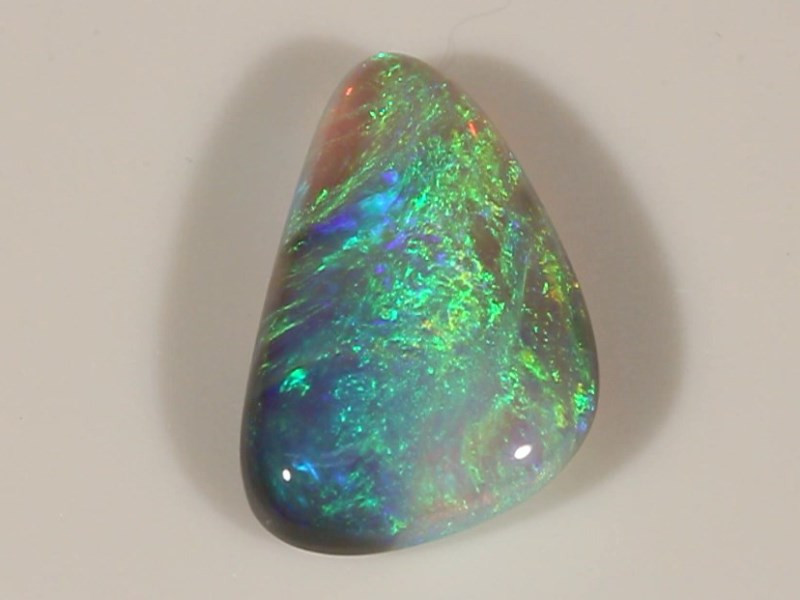 Australischer schwarzer Opal
Australischer schwarzer Opal
Afrika
Äthiopien und Kenia haben auf dem Opalmarkt für ordentlich Furore gesorgt.
Australien ist der König der Opale, aber Äthiopien konkurriert seit langem um die Krone .
Äthiopische Opale sind überwiegend weiße und cremefarbene Edelopale. In den letzten Jahren wurden in äthiopischen Lagerstätten auch die begehrten schwarzen Opale gefunden.
Der äthiopische Welo-Opal ist eine weitere atemberaubende lokale Varietät. Benannt nach der Provinz Wollo, ist der Welo-Opal ein kostbarer Feueropal mit roten, orangen und gelben Grundfarben. Welo-Opale können leuchtend grüne oder violette Farbreflexe aufweisen.
Kenia spielt eine bedeutende Rolle in der Geschichte des Opals, da hier die ältesten jemals entdeckten Opale gefunden wurden. Heutzutage ist der Gemeine Opal die am häufigsten vorkommende Opalart in Kenia. Welche Farbe haben sie? Kenias Opale weisen wunderschöne Olivgrüntöne auf.
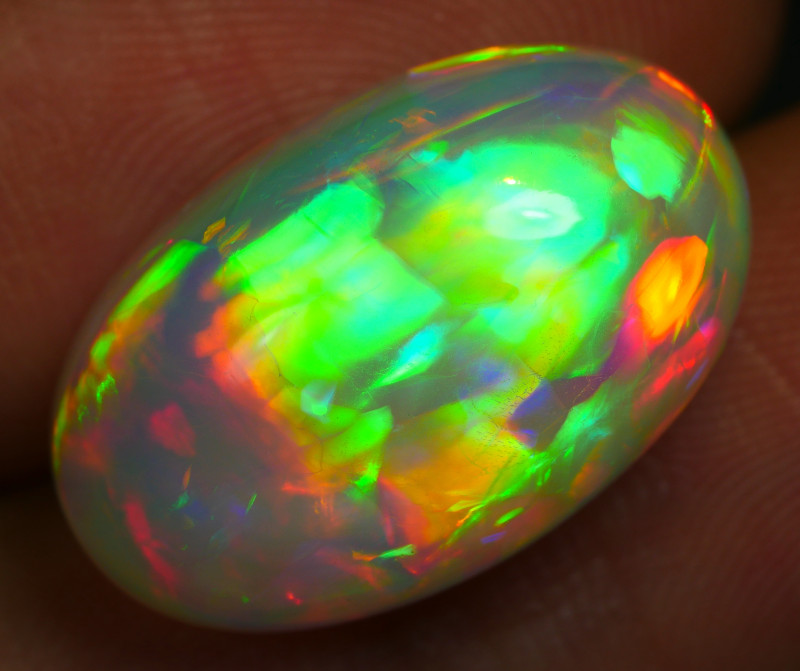 Äthiopischer Welo-Opal
Äthiopischer Welo-Opal
Südamerika
In Südamerika sind Peru und Brasilien die wichtigsten Opallieferanten des Kontinents.
Wer Pastellfarben mag, wird von der peruanischen Opalkollektion begeistert sein. Peruanische Opale gibt es in einer Vielzahl sanfter Pastelltöne, insbesondere in Rosa, Blau und Grün.
Brasilianischer Opal ist einzigartig in seiner Haltbarkeit und Brillanz. Der Kristallopal aus Brasilien zeigt ein faszinierendes Farbenspiel in mystischen Pastelltönen. Der geringe Wassergehalt dieser Edelsteine verleiht ihnen eine höhere Widerstandsfähigkeit, sodass Juweliere die Farben des Opals mit verschiedenen Facettiertechniken optimal zur Geltung bringen können.
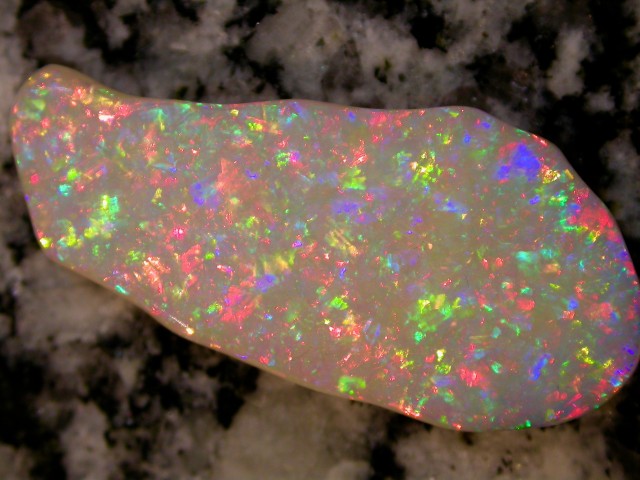 Brasilianischer Opal
Brasilianischer Opal
Mexiko
Mexiko ist stolz auf zwei einzigartige Opalfarben: den mexikanischen Feueropal und den Morado-Opal.
Während viele Opale von durchscheinend bis undurchsichtig sind, weisen mexikanische Opale eine transparente bis durchscheinende Oberfläche auf.
Die Farbe des mexikanischen Feueropals ähnelt – wenig überraschend – der Farbe des Feuers. Der Edelstein kann gelb, weiß, orange oder rot sein. Wie eine brennende Flamme weisen die schönsten Exemplare eine satte rot-orange Farbe auf.
Der Morado-Opal ist eine violette Opalvarietät. Morado bedeutet im Spanischen „violett“, daher der Name. Diese Opale sind typischerweise undurchsichtig und weisen ein milchig-lavendel-violettes Farbmuster auf.
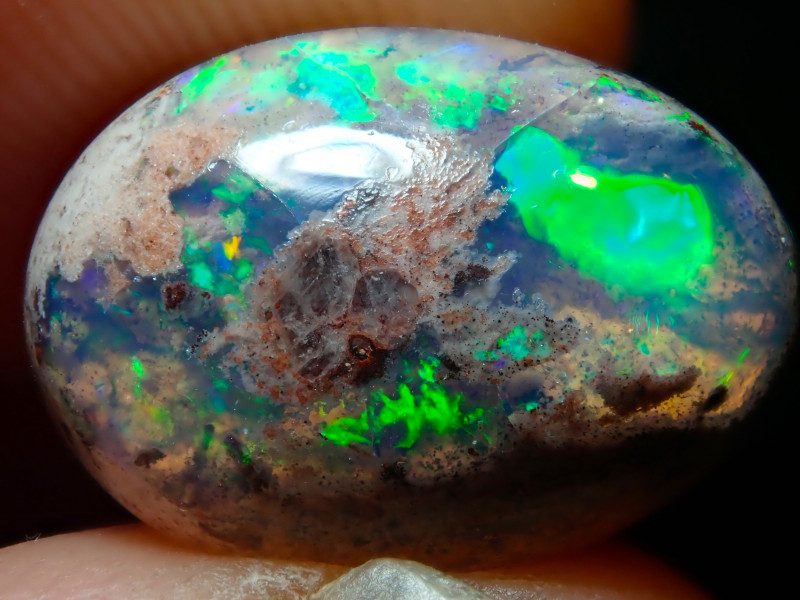 Mexikanischer Feueropal
Mexikanischer Feueropal
Vereinigte Staaten
Amerikanische Opalminen sind über das ganze Land verteilt, aber zwei bedeutende Bundesstaaten für die Opalproduktion sind Oregon und Nevada.
Oregon. Oregon besitzt zwei bedeutende Opalminen: eine in der treffend benannten Region Opal Butte und eine im Lake County. Die Opale Oregons weisen hauptsächlich Rosa-, Gelb- und Blautöne auf.
Der vulkanische Aschefall in diesem Bundesstaat schafft ideale Bedingungen für die Entstehung von Opalholz. Opalholz ist versteinertes Holz, das Opal anstelle des häufiger vorkommenden Chalcedons enthält.
Opalisiertes Holz entsteht, wenn Aschefall eine schützende Waldschicht bildet, wodurch das in der Asche gelöste Siliziumdioxid in den Boden sickern kann. Von dort aus kann Grundwasser das Siliziumdioxid aufnehmen und den üblichen Opalbildungsprozess in Gang setzen.
Nevada. Die Einheimischen von Virgin Valley in Nevada behaupten, dass sich dort vor Millionen von Jahren Opale bildeten. Opalisierte Fossilien scheinen diese Theorie zu stützen, doch niemand kann mit Sicherheit sagen, wann genau sich die Opale auf den Fossilien abgelagert haben.
Ungeachtet dessen treten die Opale des Virgin Valley in spektakulären Farben aus feuchten Tonschichten hervor. Zu den Opalen Nevadas gehören unter anderem schwarzer Opal und kostbarer schwarzer Opal. Weitere abgebauten Opalarten sind weiße und gelbe Opale sowie Opale mit Moos- oder Dendriteneinschlüssen.
Der hohe Urangehalt der Region verleiht vielen Opalen eine starke Fluoreszenz. Unter einer UV-Lampe (oder Schwarzlicht) leuchten diese Opale hellgrün.
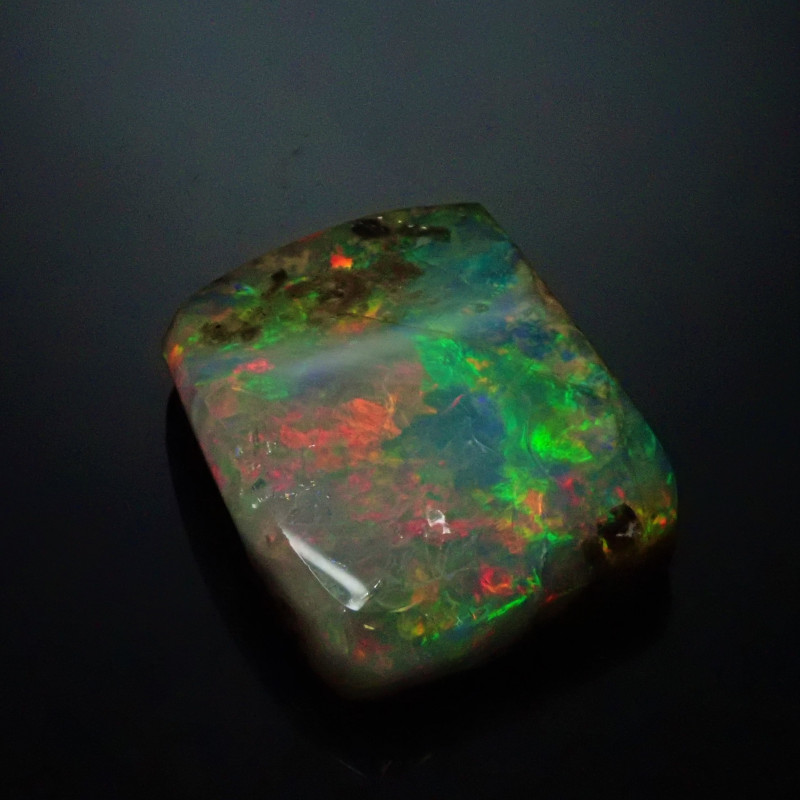 Amerikanischer Opal aus dem Virgin Valley
Amerikanischer Opal aus dem Virgin Valley
Bei all den verschiedenen Opalfarben, die es gibt, fragt man sich vielleicht: Welche Opale sind die besten zum Kaufen?
Wie die Farbe den Wert von Opalen beeinflusst
Die Wertbestimmung eines Opals ist kein einfacher Prozess. Zahlreiche Faktoren beeinflussen seinen Gesamtwert, vom Fundort über seine Form bis hin zu seinen einzigartigen Farbeigenschaften.
Generell gilt jedoch: Die wertvollsten Opale sind die seltensten Sorten, und die am häufigsten vorkommenden Opale sind die am wenigsten wertvollen.
Welche Farbe hat also den wertvollsten Opal?
Schwarze Opale sind die seltenste Opalart, wobei wertvolle schwarze Opale noch schwerer zu finden sind. Die wertvollste gängige Opalfarbe ist jedoch der seltene rote Opal. Orange, grüne, blaue und violette Opale folgen in der Wertrangliste.
Falls es Sie interessiert: Der teuerste Opal der Welt ist der „Virgin Rainbow“ (siehe Abbildung unten). Er wurde 2003 entdeckt und hat einen Wert von über einer Million Dollar. Das beeindruckende Exemplar ist derzeit im South Australian Museum ausgestellt.
 Entdecke den Opal-Regenbogen!
Entdecke den Opal-Regenbogen!
Wenn Sie jetzt schon bereit sind, Ihre Tasche zu packen und eine Opalexpedition zu planen, können wir das gut verstehen! Opal ist ein einzigartiger Edelstein, aber jeder Opal ist einzigartig!
Mit diesem Wissen im Gepäck sind Sie bestens gerüstet, um zu beeindrucken. Warum nicht statt „Was ist Ihre Lieblingsfarbe?“ fragen: „Welche Opalfarbe gefällt Ihnen am besten?“
Keine Sorge, es gibt Opalfarben in Hülle und Fülle!
Haben Sie sich schon für eine Lieblingsfarbe entschieden? Finden Sie die perfekte Opalfarbe für sich!
Suche nach Opal Encyclopedia
Verwandte Auktionen
In Verbindung stehende Artikel
Der Boulder-Opal zählt zu den wertvollsten und am meisten unterschätzten Opalen auf dem Markt. Erfahren Sie mehr über diesen einzigartigen Opal und entdecken Sie die wunderschönen Steine in unserem Angebot.
29th May 2019
Wayne und Estella Sedawie gründeten vor über 14 Jahren Opal Plus, angetrieben von ihrer Leidenschaft für Opale, und haben das Internet als wertvolles Werkzeug entdeckt. Über dieses Internet werden die meisten internationalen Transaktionen des Unternehmens abgewickelt.
17th Oct 2018
Neue Artikel
Schwarze Opale sind die begehrteste Opalart. Ihre tiefe Basis erzeugt ein regenbogenfarbenes Farbenspiel an der Oberfläche. Entdecken Sie die Verwendung, Eigenschaften, Geschichte und den Wert schwarzer Opale!
7th Dec 2025
Erfahren Sie, wie Opale bewertet werden und welche Faktoren ihren Preis beeinflussen. Von Farbe und Leuchtkraft bis hin zu Schliff und Herkunft – lernen Sie, wie die verschiedenen Opalarten bewertet werden, inklusive Preisbeispielen.
19th Jul 2023
Begeben Sie sich auf eine Reise und erfahren Sie von unserer Gastautorin Vivien Schapera von Crystal Healing Techniques mehr über die Heilkraft von Opalen!
20th May 2023
Artikelkategorien
All there is to know about Opals including Black Opals, Ethiopian Opals & Boulder Opal
14 Artikel
Check out our fascinating information and articles on all things amazing in the Opal world
41 Artikel
Opal Auctions sellers who are approved as opal Verified Sellers
4 Artikel





![OPAL IN SHIN CRACKER-NATURAL LOOK-[EJP16] 4.31 CTS](https://liveplatforms-production.b-cdn.net/tenants/oa/uploads/images/55000-59999/55996/16.jpg?width=480&aspect_ratio=1001%3A1000)
![GEM OPAL IN SHINCRACKER [ AC146 ] 10.45 CTS](https://liveplatforms-production.b-cdn.net/tenants/oa/uploads/images/25000-29999/27532/db6ad38c38487f213623b19720351dfb.jpg?width=480&aspect_ratio=1001%3A1000)
![GEM OPAL IN SHINCRACKER [ AC143 ] 5.54 CTS](https://liveplatforms-production.b-cdn.net/tenants/oa/uploads/images/25000-29999/27528/4ce93be559a65b7c0a109652fff9ff24.jpg?width=480&aspect_ratio=1001%3A1000)
![GEM OPAL IN SHINCRACKER [ AC142 ] 5.18 CTS](https://liveplatforms-production.b-cdn.net/tenants/oa/uploads/images/25000-29999/27527/6685e924fd64129f12295a3cc655abf8.jpg?width=480&aspect_ratio=1001%3A1000)